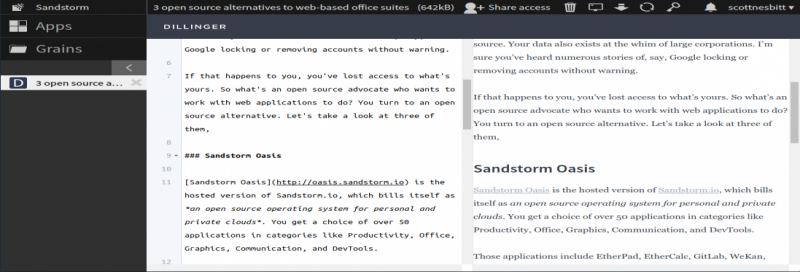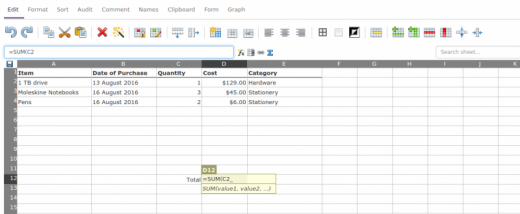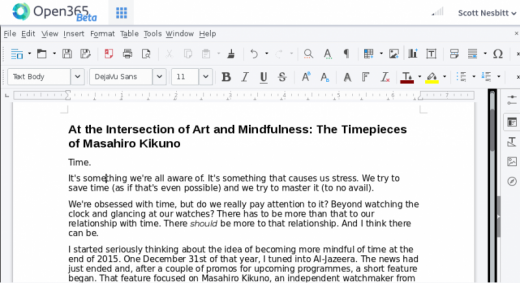[ad_1]
It can be hard to get away from working and collaborating on the web. Doing that is incredibly convenient: as long as you have an internet connection, you can easily work and share from just about anywhere, on just about any device.
The main problem with most web-based office suites—like Google Drive, Zoho Office, and Office365—is that they’re closed source. Your data also exists at the whim of large corporations. I’m sure you’ve heard numerous stories of, say, Google locking or removing accounts without warning.
If that happens to you, you lose what’s yours. So what’s an open source advocate who wants to work with web applications to do? You turn to an open source alternative, of course. Let’s take a look at three of them.
Sandstorm Oasis
Sandstorm Oasis is the hosted version of Sandstorm.io, which bills itself as an open source operating system for personal and private clouds. You get a choice of over 50 applications in categories like productivity, office, graphics, communication, and developer tools. You get just about everything you need to work, share, and collaborate.
Those applications include EtherPad, EtherCalc, GitLab, WeKan, Rocket.Chat, and Draw.io. When you fire up an application, it creates a grain. A grain is a single, standalone instance of an application, for example, a document or a chat room. You can share individual grains with others by sending them a link.
If you’re collaborating on a project, you can share a set of grains as a single package using the Collections app. Just start the app, create a collection for your project, and then add grains to the collection. It keeps things nice and neat in your instance of Sandstorm Oasis.

Writing this article using Dillinger in Sandstorm Oasis
Framasoft
Like Sandstorm Oasis, Framasoft pulls a disparate set of web apps together into one place. Unlike Sandstorm Oasis, however, the folks behind Framasoft have rebranded the applications and given them a consistent look and feel.
Framasoft includes web applications like EtherPad (called Framapad), GitLab (called Framagit), MatterMost (called Framateam), and EtherCalc (called Framacalc). The suite also includes a read-it-later tool, a vector drawing program, an RSS reader, a URL shortener, a kanban board, and file sharing tools. You can use a public instance of many apps, or sign in to keep your data private. Be ready to stretch your linguistic muscles if you want to use the Framasoft suite: most of the applications are in French, and there doesn’t seem to be a way change the interface to a different language.

Working on an expense spreadsheet using Framacalc
Open365
I can’t think of an open source user who doesn’t know and love (or, at least, like) LibreOffice. It’s not just for the desktop anymore, either. You can find it on the web in the form of Open365.
As its name suggests, Open365 is positioned as an open source rival to Microsoft’s Office 365 suite. You get a limited number of applications, which include LibreOffice mainstays Write, Calc, and Impress. There’s also an email application and a web-based version of The GIMP image editor. You also get space to store files.
Sharing documents and collaborating isn’t as easy in Open365 as it is in, say, Sandstorm Oasis. To share or collaborate, you need to create a group. Then you need to add members to that group by either uploading a CSV file containing email addresses or by selecting existing Open365 users from a pick list. In either case, those users need to have an Open365 account.
While Open365 can run a bit slowly, one of its main selling points is that it has the same look and feel as the desktop version of LibreOffice. On top of that, you can install client software on your computer to keep your files synchronized.

Working on a LibreOffice document in Open365
Do it yourself
You’ll notice that the three alternatives I discuss in this article are hosted. Even though they’re open source, you’re still at the mercy of the service offering the applications closing shop or unexpected outages.
If you have a server, however, you have a couple of options. You can download and install Sandstorm.io and Open365 on your server. Or, if you’re willing to roll your own suite and mix and match, you can install the web applications you want on your server. That won’t give you a single login, but you’ll have complete control over your applications.
Do you have a favorite alternative to Google Drive or Office 365? Feel free to share you pick by leaving a comment below.
[ad_2]
Source link